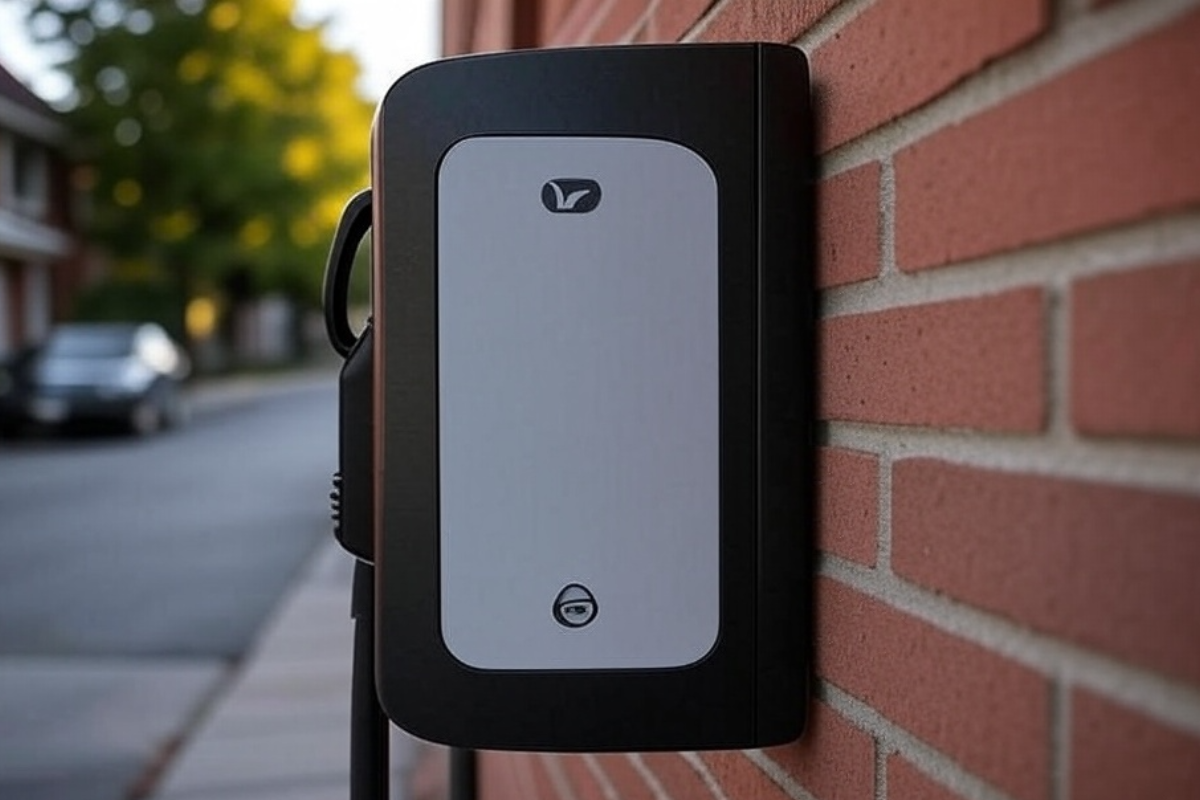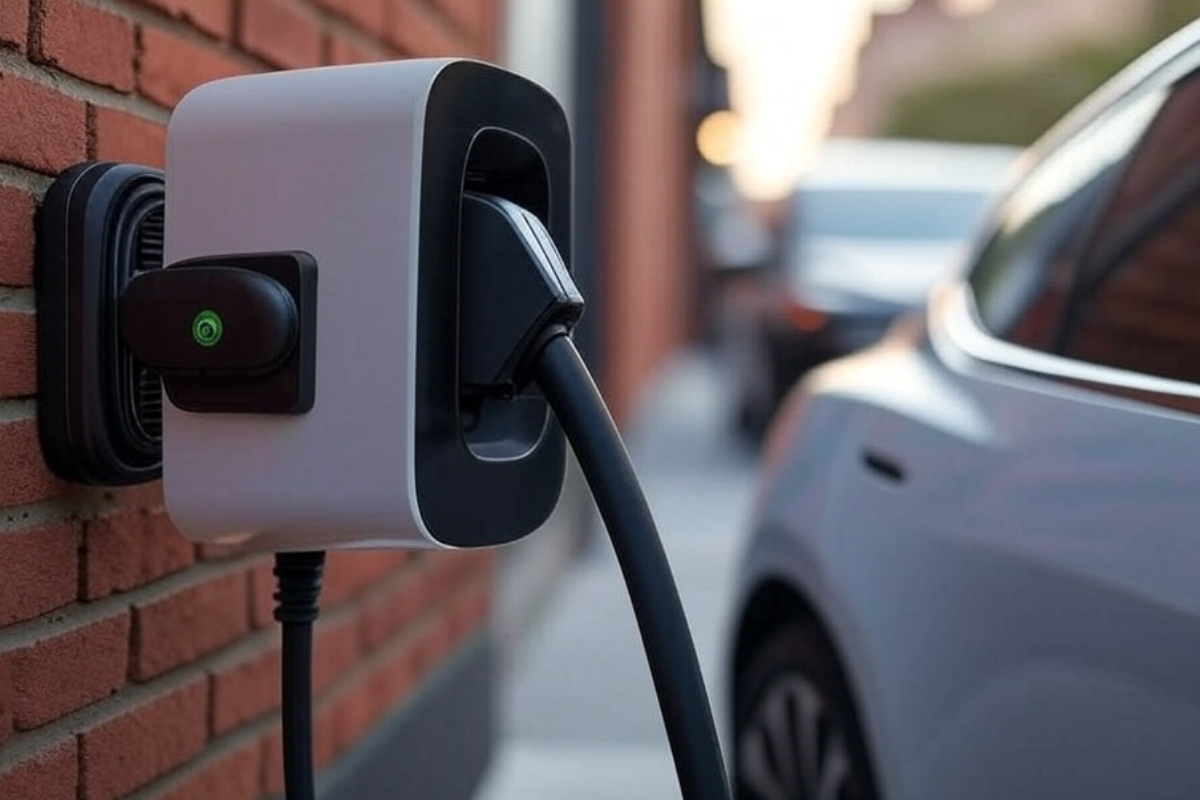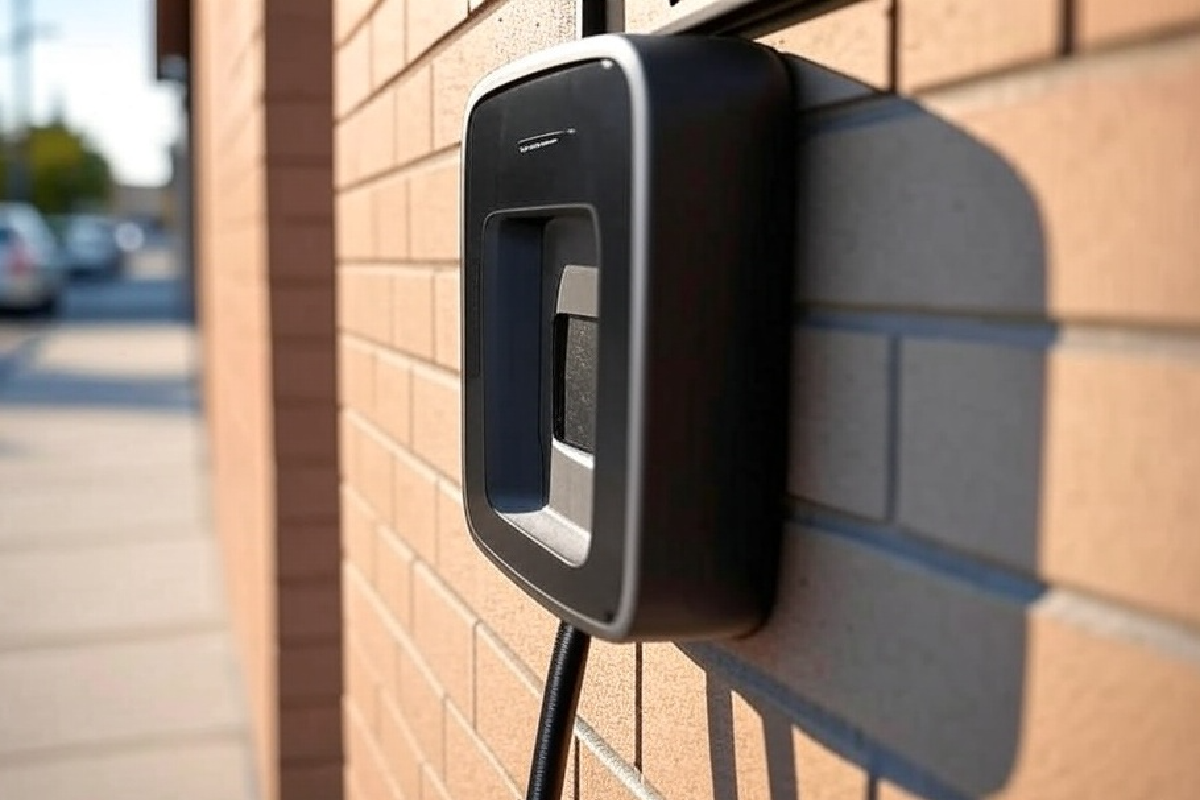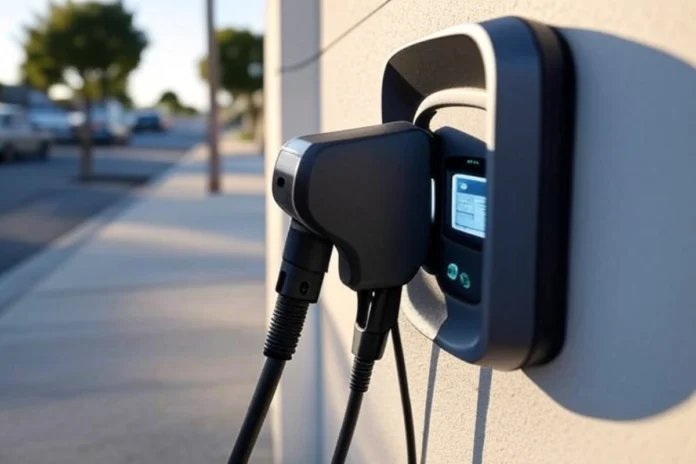Introduction to Home EV Chargers
As electric vehicles (EVs) gain popularity, the installation of home EV chargers has become increasingly significant. A home EV charger is a dedicated unit designed to charge electric vehicles using either a standard household outlet or a more powerful charging station installed on the property. With the global push towards sustainability, having a home charger is becoming a crucial component for EV owners, providing them with the necessary infrastructure to power their vehicles conveniently.
One of the primary advantages of installing a home EV charger is convenience. Instead of relying on public charging stations, which may be few and far between, homeowners can conveniently charge their electric vehicles overnight or during off-peak hours. This means that the vehicle is charged and ready for use every morning, aligning perfectly with the owner’s routine. Additionally, a home charger eliminates the stress and uncertainty of finding a nearby public charging point, especially in times of high demand.
The financial benefits associated with home EV chargers are equally compelling. By charging a vehicle at home, owners can avoid the often higher costs of using public charging stations, particularly those that charge premium rates. Furthermore, many utility companies offer lower electricity rates during specific hours, allowing homeowners to save even more on their charging costs. These savings can make owning an electric vehicle more economical in the long run.
Moreover, installing a home EV charger can potentially increase the property’s value. As the demand for electric vehicles continues to rise, having a home charger is seen as a desirable feature by potential buyers. This emerging trend indicates that properties equipped with EV chargers may stand out in the real estate market, appealing to environmentally conscious consumers and those looking to take advantage of the benefits associated with electric mobility.
Understanding Different Types of EV Chargers
As electric vehicles (EVs) continue to gain popularity, understanding the various types of EV chargers available for home use becomes essential for potential buyers. The two primary types of EV chargers are Level 1 and Level 2 chargers, each offering distinct characteristics, charging speeds, and suitability for different home setups and EV models.
Level 1 chargers utilize a standard household outlet, typically offering a voltage of 120 volts. This type of charging equipment is generally easy to set up, requiring no specialized installation. For many drivers, using a Level 1 charger provides a convenient option, especially for those who drive short distances daily. However, the charging speed is relatively slow, usually taking 8 to 12 hours to fully charge an EV, making it more ideal for overnight charging or when the vehicle is not in use for extended periods.
In contrast, Level 2 chargers operate at a higher voltage, typically 240 volts, and are designed for faster charging capabilities. These chargers usually require professional installation but can significantly reduce charging times, often providing a full charge in 4 to 6 hours or even less, depending on the specific EV model. The advantage of a Level 2 EV charger is particularly apparent for households with multiple EVs or for drivers who need to charge their vehicle more quickly due to frequent travel. Moreover, many Level 2 chargers come with smart features, such as scheduling and energy usage monitoring, providing users with enhanced convenience and efficiency.
When selecting an EV charger for home use, it is essential to consider the specific needs of your vehicle, the typical daily driving range, and available electrical infrastructure. For households with limited charging needs, a Level 1 charger may suffice, while those requiring quicker charging capabilities might opt for the advanced features of a Level 2 charger. Understanding these options is a crucial step in the process of installing a home EV charger.

Assessing Your Home’s Electrical System
Before installing a home EV charger, it is essential to evaluate your current electrical system to ensure it can support the new equipment. Begin by locating your electrical panel, commonly found in basements, garages, or utility rooms. Once located, inspect the panel for any visible damage or signs of wear, which could indicate underlying issues that may complicate your installation.
Next, determine the amperage rating of your electrical panel. Most modern EV chargers require either a 40-amp or 50-amp circuit to function effectively. Check the main breaker switch, which is usually labeled with a maximum amperage value. Additionally, it may be beneficial to evaluate how much electrical load your home currently utilizes. This can be achieved by reviewing recent utility bills or consulting with an electrician for a more detailed analysis. If your existing system is already running near its limit, you may need to consider an upgrade.
Evaluating your home’s wiring is also a critical step in the installation process. Older homes may have outdated wiring, which could pose safety hazards when operating an EV charger. Ensure that the electrical wiring is capable of handling the necessary load for charging. If it is outdated or insufficient, a professional electrician will need to upgrade it accordingly. It is important to understand any local building codes and regulations that may apply to the installation as they may dictate specific requirements for electrical upgrades.
In summary, assessing your home’s electrical system involves a thorough inspection of your panel’s amperage, the load on your current system, and the adequacy of your home’s wiring. By addressing these elements upfront, you can facilitate a smoother installation process for your EV charger and ensure optimal functionality and safety.
Selecting the Right Location for Your Charger
When it comes to installing a home EV charger, selecting the optimal location is a critical step in the process. Accessibility should be the primary consideration, as the charger needs to be easily reachable for your electric vehicle (EV). This means that the location should allow for straightforward connection without any unnecessary complications, particularly if you plan to charge the vehicle frequently.
The proximity of the charger to your parking area plays a significant role in the overall convenience of usage. Ideally, the EV charger should be situated close to where the vehicle is parked to minimize the distance you’d need to stretch the charging cable. If the charging station is too far, it may lead to tripping hazards or require additional extension cables, which can pose safety risks.
Weather conditions are another essential factor to consider when determining the placement of your charger. Choose a location that protects the charger from adverse weather elements such as rain, snow, or intense sunlight. Ideally, positioning it in a garage or under a roof can enhance both the longevity of the charger and ensure secure connections, preventing moisture-induced electrical issues.
Ensuring compliance with local regulations and codes is paramount when selecting the installation site for your EV charger. Familiarize yourself with local guidelines, as there may be specific requirements regarding the distance from property lines, as well as electrical codes that dictate safe installations. Additionally, many municipalities offer permitting processes or guidelines that simplify the understanding of what’s needed for a legal installation.
By carefully evaluating these factors—accessibility, proximity, weather considerations, and compliance with local regulations—you can ensure the successful installation of your EV charger, resulting in a more efficient and user-friendly charging experience.

Gathering Necessary Permits and Requirements
Before embarking on the journey to install a home EV charger, it is crucial to gather all necessary permits and adhere to local regulations. Each municipality has specific guidelines governing the installation of electric vehicle chargers, which can significantly impact the installation process. The first step in this guide is to conduct thorough research on the requirements within your locality. This may involve reviewing local building codes as well as zoning regulations that dictate how and where you can install such devices.
It is advisable to start by contacting your local building department or municipality. They can provide essential information and help determine the permits required for installing an EV charger at your residence. Some areas may have specific restrictions on placement or types of chargers that can be installed. Moreover, if your property is part of a homeowners association (HOA), it is also essential to check their regulations regarding modifications to your property.
In addition to local authorities, it is important to engage with your utility company. Electric vehicle chargers may require increased electrical capacity, and some utilities offer incentives for home installations. Engaging with them early in the process ensures compliance with any specific requirements, such as an electrical panel upgrade or adjustments to the existing service line. Furthermore, understanding the utility’s incentive programs could provide financial benefits, making the installation more cost-effective.
Once you have a comprehensive grasp of the permits and requirements, proceed to gather the necessary documentation. This ensures that the installation of your EV charger aligns with legal expectations, ultimately delivering a smoother and stress-free installation experience. By following this guide on permit acquisition, you’ll lay a solid foundation for a successful home EV charger setup.
Choosing the Right EV Charger
Selecting the right electric vehicle (EV) charger is crucial for ensuring optimal performance and user satisfaction. Understanding compatibility with your vehicle is the primary consideration. Most electric vehicles utilize either Level 1 or Level 2 charging stations. Level 1 chargers offer a standard household outlet connection, typically providing around 4-5 miles of range per hour of charging. However, for faster charging, many users prefer Level 2 chargers, which can deliver up to 25 miles of range per hour, making them ideal for overnight charge cycles.
Another important factor to consider is charging speed. While a higher kilowatt (kW) rating generally indicates faster charging capability, you should also assess your daily driving habits. If you have a longer daily commute, investing in a more powerful EV charger may be beneficial. Conversely, if your driving range is minimal, a less powerful charger might suffice, reducing your overall cost.
Features should also guide your decision. Many modern EV chargers come equipped with smart technology, allowing for remote monitoring and control via smartphone applications. Some models offer energy consumption tracking, which can contribute to better overall energy management in your home. Additionally, features such as weather resistance, built-in cable management, and installation flexibility can enhance user experience.
Price is a significant factor when choosing an EV charger. It is important to establish a budget and explore models within that price range. Reviewing consumer ratings and comparing multiple brands can aid in making an informed choice. Many reputable online platforms provide user-generated reviews that can help clarify the strengths and weaknesses of various chargers. To make a sound investment, consider the warranty and customer support associated with the charger, as this can be invaluable in the long run.

Hiring a Professional vs. DIY Installation
The installation of a home EV charger presents homeowners with a critical decision: whether to hire a professional electrician or undertake a do-it-yourself (DIY) approach. Both options come with their own set of advantages and challenges that must be carefully considered.
One of the primary benefits of hiring a professional is safety. Electricians possess the necessary training and experience to handle electrical systems, ensuring that the installation adheres to local codes and regulations. This expertise reduces the risk of electrical fires, shock, or other accidents that may arise from improper installation. Moreover, should any issues arise post-installation, homeowners can rest assured knowing they have access to warranty or service support from a qualified technician.
Conversely, opting for a DIY installation can offer significant cost savings. Homeowners save on labor costs and can potentially install the EV charger at their convenience. For those with a solid understanding of electrical systems and installation guidelines, this approach can be both rewarding and cost-efficient. However, the DIY route also carries inherent risks. Without adequate knowledge, individuals may overlook vital safety measures or fail to comply with electrical codes, leading to long-term repercussions.
Cost is also a significant factor that influences the decision. Professional installation can range from several hundred to a few thousand dollars, depending on the complexity of the job and local labor rates. DIY installations may lower upfront costs, but it is crucial to factor in the price of tools, materials, and any potential service costs associated with mistakes or adjustments. Ultimately, this decision should consider personal skill levels, budget constraints, and the specific characteristics of the home’s electrical system. By weighing these factors, homeowners can make an informed choice between hiring a professional or undertaking a DIY installation for their EV charger.
Step-by-Step Installation Process
Installing a home EV charger can be a rewarding endeavor, allowing electric vehicle (EV) owners to recharge conveniently at home. Below is a comprehensive guide to ensure a successful installation process.
Firstly, prepare the site where the EV charger will be mounted. Choose an appropriate location, preferably near the parking space, ideally in a sheltered area to protect it from the elements. Clear any obstacles and ensure the surface is level and sturdy. Always check local regulations to determine if a permit is required for installation.
Once the site is ready, the next step is to mount the EV charger on the wall or a post. Using a stud finder, locate wall studs if you are mounting it on a wall. After marking the drill holes, carefully drill into the surface and secure the charger using the provided mounting hardware. Ensure that it is firmly attached and at a convenient height for ease of use.
The following step involves making electrical connections. Before proceeding, turn off the power supply to avoid any electrical hazards. Using appropriate wiring, connect the charger to your home’s electrical system, following the manufacturer’s instructions carefully. It is recommended to use a licensed electrician for this part if you are not familiar with electrical systems, as improper installation can pose safety risks.
After completing the electrical connections, turn the power back on and test the installation. Plug in your EV to the charger and check for any warning lights or notifications. Make sure the EV charger is functioning correctly by monitoring its performance during the first charge cycle.
By following this detailed guide, you can ensure a safe and effective installation of your home EV charger, enabling you to enjoy the convenience of charging your electric vehicle at your own convenience.
Conclusion and Maintenance Tips
In conclusion, installing a home EV charger can significantly enhance your electric vehicle ownership experience, providing the convenience of charging at home and reducing dependency on public charging stations. This guide has taken you through the essential steps required for a successful installation, ranging from selecting the appropriate charger suited to your vehicle’s specifications to the actual installation process itself. By following these steps, you not only ensure compliance with safety standards but also maximize the efficiency of your EV charging setup.
To maintain optimal performance and safety of your EV charger, regular maintenance is crucial. Begin by routinely inspecting the charging unit for any signs of wear, damage, or dirt accumulation. Pay particular attention to the cables and connectors, as these components often suffer from environmental exposure leading to potential hazards. Ensure that the connections are clean and free from corrosion to maintain an efficient charge.
Keeping the EV charger clean is straightforward; use a soft, damp cloth to wipe the exterior, and avoid harsh chemicals that might deteriorate the materials. Additionally, it is advisable to periodically check the electrical connections for signs of loosening. If any issues arise, consulting a professional electrician is highly recommended to ensure the safety and integrity of your home EV charging system.
Lastly, familiarize yourself with the manufacturer’s guidelines and recommendations for your specific charger model. Some chargers may require software updates for better performance or new features. Adhering to these maintenance tips will help ensure that your home EV charger remains operational, safeguarding your investment while promoting a more sustainable transportation alternative.




